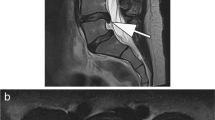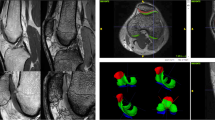Abstract
The increasing distribution of high-field (3 T) magnetic resonance (MR) systems for clinical use has been accompanied by the need to fully understand the advantages and disadvantages that the increase in signal quality confers. Continuous development of the coils is required to fully express the potential of these systems, especially given the synergy between parallel imaging and the recent multichannel phased-array coils, which are able to improve image quality, spatial resolution and diagnostic accuracy in musculoskeletal imaging. The increase in signal offered by the high field makes possible improved visualisation of bone, cartilage, tendons and ligaments. This advantage, together with increased spatial resolution, is particularly useful when studying joints or some of their components, the evaluation of which has produced suboptimal results in non arthrographic examinations such as the glenoid labrum of the shoulder and the articular cartilage of the knee. Thanks to the greater signal-to-noise ratio and improved spatial resolution, MR imaging at 3 T is able to notably increase diagnostic performance in the musculoskeletal setting, with a consequent improvement in patient treatment and management.
Riassunto
Ad una maggiore diffusione di apparecchiature ad alto campo (3 T) ad utilizzo clinico si accompagna la necessità di comprendere appieno i vantaggi e gli svantaggi apportati dall’incremento della quantità di segnale. Un continuo sviluppo delle bobine è necessario per esprimere il potenziale di tali apparecchiature, specialmente in considerazione della sinergia esistente tra imaging parallelo e le recenti bobine multicanale phased array, in grado di migliorare qualità dell’immagine, risoluzione spaziale ed accuratezza diagnostica in ambito muscoloscheletrico. L’incremento del segnale offerto dall’alto campo consente una migliore visualizzazione delle strutture ossee, tendinee, cartilaginee e legamentose. Tale vantaggio, unito ad una maggiore risoluzione spaziale, risulta particolarmente utile nello studio delle articolazioni o di alcune loro componenti fino ad oggi valutabili in maniera subottimale con esami non artrografici, quali il labbro glenoideo della spalla e la cartilagine articolare del ginocchio. Grazie al maggiore rapporto segnale/rumore ed alla maggiore risoluzione spaziale, l’imaging in risonanza magnetica (RM) a 3 T è in grado di incrementare notevolmente la capacità diagnostica in campo muscolo-scheletrico, con conseguente miglioramento della cura e della gestione del paziente.
Similar content being viewed by others
References/Bibliografia
Di Costanzo A, Pollice S, Trojsi F et al (2008) Role of perfusion-weighted imaging at 3 Tesla in the assessment of malignancy of cerebral gliomas. Radiol Med 113:134–143
Scarabino T, Popolizio T, Giannatempo GM et al (2007) 3.0-T morphological and angiographic brain imaging: a 5-years experience. Radiol Med 112:82–96
Scarabino T, Giannatempo GM, Popolizio T et al (2007) 3.0-T functional brain imaging: a 5-year experience. Radiol Med 112:97–112
Parker DL, Gullberg GT (1990) Signalto-noise efficiency in magnetic resonance imaging. Med Phys 17:250–257
Gold GE, Han E, Stainsby J et al (2004) Musculoskeletal MRI at 3.0 T: relaxation times and image contrast. AJR Am J Roentgenol 183:343–351
Hood MN, Ho VB, Smirniotopoulos JG et al (1999) Chemical shift: the artifact and clinical tool revisited. Radiographics 19:357–371
Naganawa S, Koshikawa T, Nakamura T et al (2004) Comparison of flow artifacts between 2D-FLAIR and 3D-FLAIR sequences at 3T. Eur Radiol 14:1901–1908
Romer PB, Edelstein WA, Hayes CE et al (1990) The NMR phased array. Magn Reson Med 16:192–225
Eckstein F, Kunz M, Hudelmaier M et al (2007) Impact of coil design on the contrast-to-noise ratio, precision, and consistency of quantitative cartilage morphometry at 3 Tesla: a pilot study for the osteoarthritis initiative. Magn Reson Med 57:448–454
Sodickson DK, Manning WJ (1997) Simultaneous acquisitions of spatial harmonics (SMASH): fast imaging with radiofrequency coil arrays. Magn Reson Med 38:591–603
Pruessman KP, Weiger M, Scheidegger MB et al (1999) SENSE: sensitivity encoding for fast MRI. Magn Reson Med 42:952–962
Pruessman KP (2004) Parallel imaging at high field strength: synergies and joint potential. Top Magn Reson Imaging 15:237–244
Mosher TJ (2006) Musculoskeletal imaging at 3T: current techniques and future applications. Magn Reson Imaging Clin N Am 14:63–76
Schmitt F, Grosu D, Mohr C et al (2004) 3 Tesla MRI: successful results with higher field strengths. Radiologe 44:31–47
Ramnath RR (2006) 3T MR imaging of the musculoskeletal system (Part II): clinical applications. Magn Reson Imaging Clin N Am 14:41–62
Magee TM, Shapiro M, Williams D (2003) Comparison of high-field-strength versus low field-strength MRI of the shoulder. AJR Am J Roentgenol 181:1211–1215
Tavernier T, Cotten A (2005) High-versus low-field MR imaging. Radiol Clin North Am 43:673–681
Magee TH, Williams D (2006) Sensitivity and specificity in detection of labral tears with 3.0-T MRI of the shoulder. AJR Am J Roentgenol 187:1448–1452
Meister K, Thesing J, Montgomery WJ et al (2004) MR arthrography of partial thickness tears of the undersurface of the rotator cuff: an arthroscopic correlation. Skeletal Radiol 33:136–141
Sundberg TP, Toomayan GA, Major NM (2006) Evaluation of the acetabular labrum at 3.0-T MR Imaging compared with 1,5-T MR artrhrography. Radiology 238:706–711
Magee TH, Williams D (2006) 3.0-T MRI of the supraspinatus tendon. AJR Am J Roentgenol 187:881–886
Watson RM, Roach NA, Dalinka MK (2004) Avascular necrosis and bone marrow edema syndrome. Radiol Clin North Am 42:207–219
Mintz DN, Hooper T, Connel D et al (2005) Magnetic resonance imaging of the hip: detection of labral and chondral abnormalities using noncontrast imaging. Arthroscopy 21:385–393
Ramnath RR, Magee T, Wasudev N (2006) Accuracy of 3 T MRI using fast spin-echo technique to detect meniscal tears of the knee. AJR Am J Roentgenol 187:221–225
Magee T, Williams D (2006) 3.0-T MRI of meniscal tears. AJR Am J Roentgenol 187:371–375
Gold GE, Reeder SB, Yu H et al (2006) Articular cartilage of the knee: rapid three-dimensional MR imaging at 3.0 T with IDEAL balanced steady-state free precession-initial experience. Radiology 240:546–551
Mosher TJ, Dardzinsky BJ (2004) Cartilage MRI T2 relaxation time mapping: overview and applications. Semin Musculoskelet Radiol 8:355–368
Stannard JP, Brown SL, Farris RC et al (2005) Reconstruction of the posterolateral corner of the knee. Arthroscopy 21:1051–1059
Robinson JR, Sanchez-Ballester J, Bull AM et al (2004) The posteromedial corner revisited. An anatomical description of the passive restraining structures of the medial aspect of the human knee. J Bone Joint Surg Br 86:674–681
Haims AH, Moore AE, Schweitzer ME et al (2004) MRI in the diagnosis of cartilage injury in the wrist. AJR Am J Roentgenol 182:1267–1270
Haims AH, Schweitzer ME, Morrison WB et al (2003) Internal derangement of the wrist: indirect MR arthrography versus unenhanced MR imaging. Radiology 227:701–707
Lenk S, Ludescher B, Martirosan P et al (2004) 3T high resolution MR imaging of carpal ligaments and TFCC. Rofo 176:664–667
Saupe N, Prussman KP, Luechinger R et al (2005) MR imaging of the wrist: comparison between 1.5- and 3 T MR imaging-preliminary experience. Radiology 234:256–264
Saupe N, Pfirrmann CW, Smidth MR et al (2007) MR imaging of cartilage in cadaveric wrists: comparison between imaging at 1.5 and 3.0 T and gross pathologic inspection. Radiology 243:180–187
Shapiro MD (2006) MR imaging of the spine at 3 T. Magn Reson Imaging Clin N Am 14:97–108
Lin W, An H, Chen Y et al (2003) Practical consideration for 3T imaging. Magn Reson Imaging Clin N Am 11:615–639
Wehrli FW, Song HK, Saha PK, Wright AC (2006) Quantitative MRI for the assessment of bone structure and function. NMR Biomed 19:731–764
Majumdar S (2008) Magnetic resonance imaging for osteoporosis. Skeletal Radiol 37:95–97
Davis CA, Genant HK, Dunham JS (1986) The effects of bone on proton NMR relaxation times surrounding liquids. Invest Radiol 21:472–477
Rosenthal H, Thulborn KR, Rosenthal DI et al (1990) Magnetic susceptibility effects of trabecular bone on magnetic resonance bone marrow imaging. Invest Radiol 25:173–178
Chung H, Wehrli FW, Williams JL, Kugelmass SD (1993) Relationship between NMR transverse relaxation, trabecular bone architecture, and strength. Proc Natl Acad Sci USA 90:10250–10254
Jergas MD, Majumdar S, Keyak JH et al (1995) Relationship between young modulus of elasticity, ash density, and MRI derived effective transverse relaxation T2* in tibial specimens. J Comput Assist Tomogr 19:472–479
Wehrli FW, Hilaire L, Fernández-Seara M et al (2002) Quantitative magnetic resonance imaging in the calcaneus and femur of women with varying degrees of osteopenia and vertebral deformity status. J Bone Miner Res 17:2265–2273
Guglielmi G, Toffanin R, Accardo A et al (2007) Quantitative MRI at 3 Tesla: T2* of the calcaneus in women with varying degrees of spinal bone minera density and vertebral fracture status. Proceedings of the 93rdAnnual Meeting of the Radiological Society of North America, p 325
Toffanin R, Cadioli M, Scotti G, Cova MA (2006) Ultrafast T2* mapping of bone marrow at 1.5 Tesla and 3.0 Tesla. Proceedings of the 14th Annual Meeting of the International Society for Magnetic Resonance in Medicine, p 3631
Dahnke H, Schaeffter T (2005) Limits of detection of SPIO at 3.0 T using T2* relaxometry. Magn Reson Med 53:1202–1206
Majumdar S, Kothari M, Augat P et al (1998) High-resolution magnetic resonance imaging: three-dimensional trabecular bone architecture and biomechanical properties. Bone 22:445–454
Scheffler K, Lehnhardt S (2003) Principles and applications of balanced SSFP techniques. Eur Radiol 13:2409–2418
Hargreaves BA, Gold GE, Beaulieu CF et al (2003) Comparison of new sequences for high-resolution cartilage imaging. Magn Reson Med 49:700–709
Banerjee S, Han ET, Krug R et al (2005) Application of refocused steady-state free-precession methods at 1.5 and 3 T to in vivo high-resolution MRI of trabecular bone: simulations and experiments. J Magn Reson Imag 21:818–825
Krug R, Han ET, Banerjee S, Majumdar S (2006) Fully balanced steady-state 3D spin-echo (bSSSE) imaging at 3 Tesla. Magn Reson Med 56:1033–1040
Author information
Authors and Affiliations
Corresponding author
Rights and permissions
About this article
Cite this article
Guglielmi, G., Biccari, N., Mangano, F. et al. 3 T magnetic resonance imaging of the musculoskeletal system. Radiol med 115, 571–584 (2010). https://doi.org/10.1007/s11547-010-0521-4
Received:
Accepted:
Published:
Issue Date:
DOI: https://doi.org/10.1007/s11547-010-0521-4




